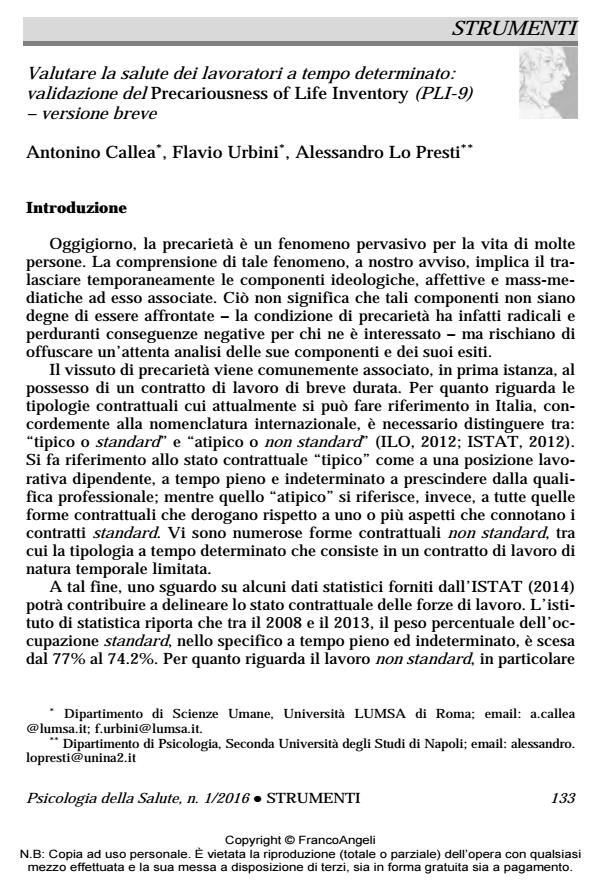Valutare la salute dei lavoratori a tempo determinato: validazione del Precariousness of Life Inventory (PLI-9) - versione breve
Titolo Rivista PSICOLOGIA DELLA SALUTE
Autori/Curatori Antonino Callea, Flavio Urbini, Alessandro Lo Presti
Anno di pubblicazione 2016 Fascicolo 2016/1
Lingua Italiano Numero pagine 17 P. 133-149 Dimensione file 154 KB
DOI 10.3280/PDS2016-001011
Il DOI è il codice a barre della proprietà intellettuale: per saperne di più
clicca qui
Qui sotto puoi vedere in anteprima la prima pagina di questo articolo.
Se questo articolo ti interessa, lo puoi acquistare (e scaricare in formato pdf) seguendo le facili indicazioni per acquistare il download credit. Acquista Download Credits per scaricare questo Articolo in formato PDF

FrancoAngeli è membro della Publishers International Linking Association, Inc (PILA)associazione indipendente e non profit per facilitare (attraverso i servizi tecnologici implementati da CrossRef.org) l’accesso degli studiosi ai contenuti digitali nelle pubblicazioni professionali e scientifiche
Negli ultimi anni, l’attenzione dell’opinione pubblica e degli studiosi verso il concetto di precarietà è cresciuta considerevolmente di pari passo all’instabilità e alle turbolenze del mercato del lavoro. Diviene quindi necessario comprendere tale fenomeno data la sua pervasività per una quota crescente e significativa della forza lavoro, da cui l’obiettivo del presente studio: validare una scala breve sulla precarietà di vita a 9 item (Precariousness of Life Inventory, PLI-9). A tale scopo hanno partecipato allo studio 721 lavoratori a tempo determinato, che hanno compilato una batteria self-report contenente il PLI-9 e altre scale riguardanti costrutti convergenti. I risultati dell’analisi fattoriale esplorativa, condotta su 341 partecipanti, e confermativa, condotta su 380 partecipanti, hanno confermato la struttura tridimensionale dello strumento (i.e., disinteresse verso il lavoro attuale, sfiducia verso il futuro professionale, conseguenze emotive nella vita quotidiana). L’analisi della validità convergente delle tre dimensioni, le quali presentano altresì adeguati indici di coerenza interna, ha mostrato correlazioni significative con costrutti inerenti la salute ed il lavoro. Infine, il calcolo dei criteri interpretativi consente di individuare i lavoratori con alta precarietà di vita. Il PLI-9 ha esibito qualità psicometriche che ne fanno al contempo uno strumento completo e snello per valutare un fenomeno, quale quello della precarietà di vita, che interessa (e plausibilmente continuerà ad interessare), in termini negativi, una quota importante della popolazione attiva.
Parole chiave:Precarietà, insicurezza lavorativa, salute, ansia, depressione
- To Be or Not to be Temp? An Analysis of the Moderating Role of Motives for Accepting Temporary Employment Alessandro Lo Presti, Antonino Callea, Sara Pluviano, in Canadian Journal of Administrative Sciences / Revue Canadienne des Sciences de l'Administration /2019 pp.473
DOI: 10.1002/cjas.1522 - Perceived Job Insecurity and Sustainable Wellbeing: Do Coping Strategies Help? Marianna Giunchi, Anne-Marie Vonthron, Chiara Ghislieri, in Sustainability /2019 pp.784
DOI: 10.3390/su11030784 - The Effect of Job Insecurity and Life Uncertainty on Everyday Consumptions and Broader Life Projects during COVID-19 Pandemic Antonio Chirumbolo, Antonino Callea, Flavio Urbini, in International Journal of Environmental Research and Public Health /2021 pp.5363
DOI: 10.3390/ijerph18105363 - The effects of a non-adaptive school-to-work transition on transition to adulthood, time perspective and internalizing and externalizing problems Anna Parola, Jenny Marcionetti, Luigia Simona Sica, Lucia Donsì, in Current Psychology /2023 pp.25855
DOI: 10.1007/s12144-022-03605-x - Sospesi nel tempo. Inattività e malessere percepito in giovani adulti NEET Anna Parola, Lucia Donsì, in PSICOLOGIA DELLA SALUTE 3/2018 pp.44
DOI: 10.3280/PDS2018-003003 - Living in Liquid Times: The Relationships among Job Insecurity, Life Uncertainty, and Psychosocial Well-Being Antonio Chirumbolo, Antonino Callea, Flavio Urbini, in International Journal of Environmental Research and Public Health /2022 pp.15225
DOI: 10.3390/ijerph192215225
Antonino Callea, Flavio Urbini, Alessandro Lo Presti, Valutare la salute dei lavoratori a tempo determinato: validazione del Precariousness of Life Inventory (PLI-9) - versione breve in "PSICOLOGIA DELLA SALUTE" 1/2016, pp 133-149, DOI: 10.3280/PDS2016-001011